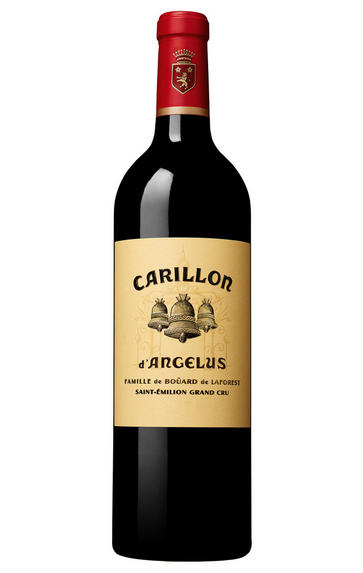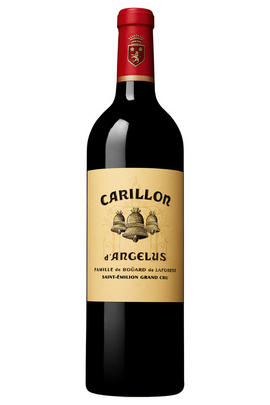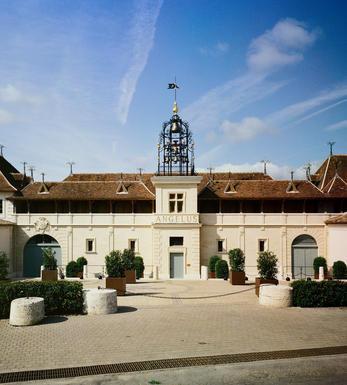
2021 Carillon d'Angélus, St Emilion, Bordeaux

Critics reviews
The 2021 Le Carillon d'Angélus offers a mixture of red and black fruit on the nose, hints of cedar and clove, and even a touch of pain d'épices. The palate is medium-bodied with pliant tannins, a fine bead of acidity, good weight and freshness and a suave and very harmonious finish. I have remarked on the melioration of Carillon in the last two years, and this continues that trend.
Neal Martin, vinous.com, (May 2022)
A huge step up from No 3, you find far more depth through the palate here, with subdued power, black pepper and clove spice, sculpted, fresh and juicy with raspberry purée and gooseberry fruits. More graphite than I find in a normal year with this wine, and on-the-edge gunsmoke reduction, partly I am sure from the vintage, and partly from the added precision of the new 4,500m2 cellar. 60% new oak with the rest in stainless steel, 16hl/h yield.
Drink 2025 - 2036
Jane Anson, janeanson.com (May 2022)
Now benefiting from its own dedicated winery, the 2021 Le Carillon d'Angélus is no longer a second wine per se, but rather draws on some 25 hectares of dedicated vineyards, emphasizing Merlot from the cool terroirs of Saint-Christophe-des-Bardes, complemented by holdings in the gravelly Figeac sector and on clay soils near Angélus itself—with anything that doesn't make the cut relegated to the No. 3 d'Angélus. Exhibiting aromas of raspberries, plums, warm spices and nicely integrated new oak, it's medium to full-bodied, supple and polished, with lively acids, refined tannins and a long, penetrating finish.
William Kelley, Wine Advocate (Apr 2022)
About this WINE

Château Angélus
Château Angélus is one of the largest and most prestigious estates in St Emilion. It was promoted to Premier Grand Cru Classé A status in the 2012 reclassification. The de Boüard family has made wine here since 1782. The estate is now run by eighth-generation Stéphanie de Boüard-Rivoal, who took over from her father, Hubert de Boüard de Laforest, and uncle, Jean-Bernard Grenié, in 2012. It is located in centre-west of the St Emilion appellation, due west of the medieval town.
Angélus’s 39 hectares of vineyards are situated less than a kilometre away from the famous St Emilion steeple. The site enjoys a perfect southerly-exposed slope. Cabernet Franc is grown at the bottom, where the soils are sandier and warmer; Merlot is grown in the limestone-rich clay soils at the top of the slope.

St Émilion
St Émilion is one of Bordeaux's largest producing appellations, producing more wine than Listrac, Moulis, St Estèphe, Pauillac, St Julien and Margaux put together. St Emilion has been producing wine for longer than the Médoc but its lack of accessibility to Bordeaux's port and market-restricted exports to mainland Europe meant the region initially did not enjoy the commercial success that funded the great châteaux of the Left Bank.
St Émilion itself is the prettiest of Bordeaux's wine towns, perched on top of the steep limestone slopes upon which many of the region's finest vineyards are situated. However, more than half of the appellation's vineyards lie on the plain between the town and the Dordogne River on sandy, alluvial soils with a sprinkling of gravel.
Further diversity is added by a small, complex gravel bed to the north-east of the region on the border with Pomerol. Atypically for St Émilion, this allows Cabernet Franc and, to a lesser extent, Cabernet Sauvignon to prosper and defines the personality of the great wines such as Ch. Cheval Blanc.
In the early 1990s there was an explosion of experimentation and evolution, leading to the rise of the garagistes, producers of deeply-concentrated wines made in very small quantities and offered at high prices. The appellation is also surrounded by four satellite appellations, Montagne, Lussac, Puisseguin and St. Georges, which enjoy a family similarity but not the complexity of the best wines.
St Émilion was first officially classified in 1954, and is the most meritocratic classification system in Bordeaux, as it is regularly amended. The most recent revision of the classification was in 2012

Merlot/Cabernet Franc
Merlot and Cabernet Franc are grape varieties commonly used in Bordeaux-style blends, particularly in the Bordeaux region of France. When these two grapes are blended, they can create a wine that combines the best characteristics of each variety.
Merlot is known for its smoothness, soft tannins, and ripe fruit flavours. It often contributes black cherry, plum, and chocolate flavours to the blend. The grapes are relatively easy to grow and ripen earlier than other Bordeaux varieties, making them versatile for blending.
Cabernet Franc, on the other hand, adds structure, depth, and complexity to the blend. It typically brings aromas of red fruits such as raspberry and strawberry, along with herbal notes like bell pepper and tobacco. These grapes have thinner skins and can be more challenging to cultivate, requiring specific growing conditions to reach their full potential.
When Merlot and Cabernet Franc are combined, the result is a well-balanced wine with various flavours and aromas. The blend often exhibits a Bordeaux wine's medium to full body, along with a smooth texture and moderate tannins. The specific flavour profile can vary depending on the proportions of each grape in the blend and the terroir and winemaking techniques employed.


Buying options
Add to wishlist
Description
Merlot 80%, Cabernet Franc 20%
Merlot 80%, Cabernet Franc 20%Carillon now has its own winery and some of its own dedicated vineyards, spread over the cooler plots of the estate – helping to retain freshness in the Merlot-dominated blend. It is smooth, with plenty of sweet blackberry and hedgerow fruits, and small, crunchy berries. A gentle floral note and hint of menthol brings freshness to complement the ripe, plush nature of the fruit. It is nicely balanced with a juicy dash of acidity on the finish. Drink 2024-2035.
Our score: 16/20
Berry Bros. & Rudd, April 2022
wine at a glance
Delivery and quality guarantee